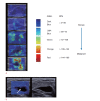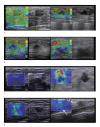Practice guideline for the performance of breast ultrasound elastography
- PMID: 24936489
- PMCID: PMC4058975
- DOI: 10.14366/usg.13012
Practice guideline for the performance of breast ultrasound elastography
Abstract
Ultrasound (US) elastography is a valuable imaging technique for tissue characterization. Two main types of elastography, strain and shear-wave, are commonly used to image breast tissue. The use of elastography is expected to increase, particularly with the increased use of US for breast screening. Recently, the US elastographic features of breast masses have been incorporated into the 2nd edition of the Breast Imaging Reporting and Data System (BI-RADS) US lexicon as associated findings. This review suggests practical guidelines for breast US elastography in consensus with the Korean Breast Elastography Study Group, which was formed in August 2013 to perform a multicenter prospective study on the use of elastography for US breast screening. This article is focused on the role of elastography in combination with B-mode US for the evaluation of breast masses. Practical tips for adequate data acquisition and the interpretation of elastography results are also presented.
Keywords: Breast, neoplasms; Elasticity imaging techniques; Ultrasonography.
Figures




References
-
- Itoh A, Ueno E, Tohno E, Kamma H, Takahashi H, Shiina T, et al. Breast disease: clinical application of US elastography for diagnosis. Radiology. 2006;239:341–350. - PubMed
-
- Cho N, Jang M, Lyou CY, Park JS, Choi HY, Moon WK. Distinguishing benign from malignant masses at breast US: combined US elastography and color doppler US--influence on radiologist accuracy. Radiology. 2012;262:80–90. - PubMed
-
- Yi A, Cho N, Chang JM, Koo HR, La Yun B, Moon WK. Sonoelastography for 1,786 non-palpable breast masses: diagnostic value in the decision to biopsy. Eur Radiol. 2012;22:1033–1040. - PubMed
-
- Harvey J. Breast US: What's new in BI-RADS 2012? In: The 44th Annual Congress of Korean Society of Ultrasound in Medicine. In: The 44th Annual Congress of Korean Society of Ultrasound in Medicine; 2013 May 25; Seoul, Korea. 2013. p.138
Publication types
LinkOut - more resources
Full Text Sources
Other Literature Sources

